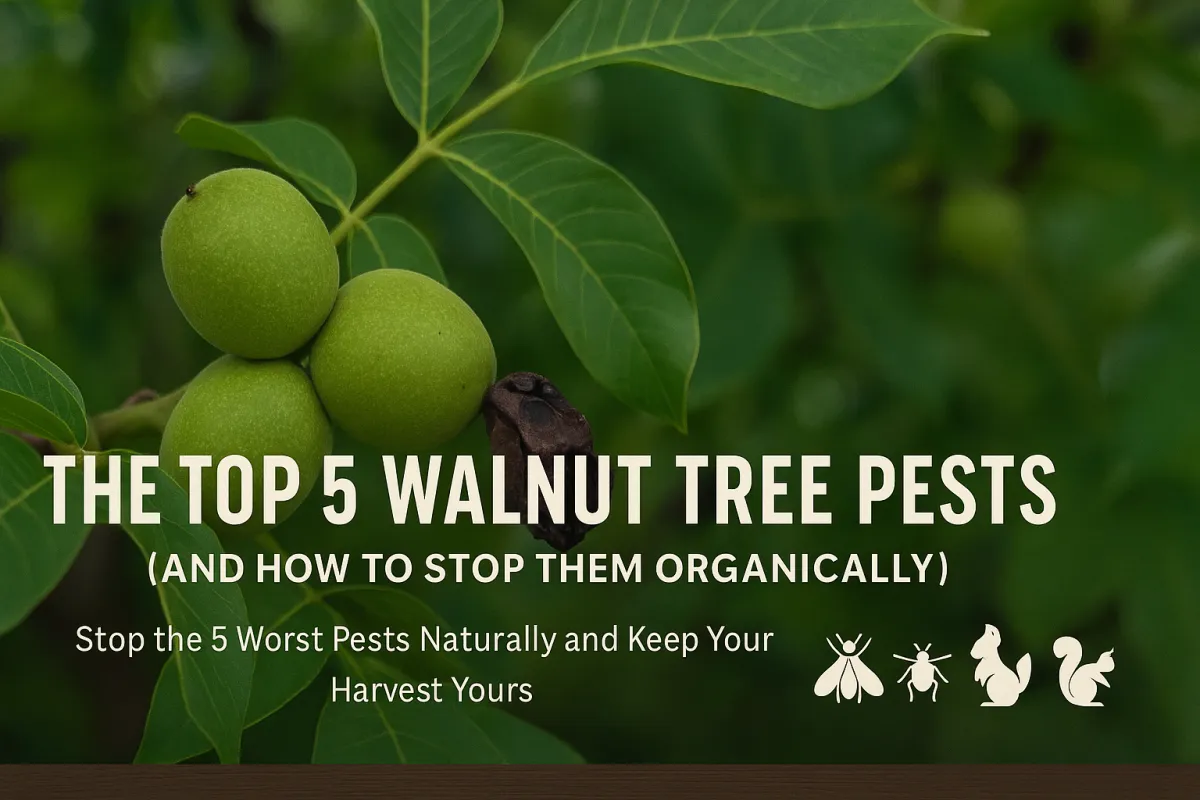
The Top 5 Walnut Tree Pests (and How to Stop Them Organically)
The Top 5 Walnut Tree Pests (and How to Stop Them Organically)
The Year the Squirrels Won
One fall, I thought I had it made. My walnut tree was loaded — the kind of crop you brag about to your neighbors. But by the time I grabbed a bucket and headed out, the squirrels had already hosted their own nut buffet. Between them and a few other culprits, I barely got enough to fill a basket.
That year taught me a hard truth: walnut trees may be tough, but pests and wildlife can take your crop faster than you think. If you want to keep your harvest for yourself, you need a plan. Here are the top five walnut tree pests I’ve battled — and the organic ways to beat them.
Why Pest Pressure Matters
Walnut trees (especially English and black walnuts) thrive in USDA Zones 5–9, but they face steady pressure from insects and animals. Left unchecked, pests don’t just ruin your nut crop — they can weaken the tree, invite disease, and reduce future yields. A proactive approach keeps your orchard productive for years to come.
1. Walnut Husk Fly: The Nut-Destroying Maggot
How to Spot Them
If you see black, mushy husks and shriveled nuts inside, you’ve got walnut husk fly. These small flies lay eggs mid-summer. The larvae tunnel through the husk, staining it black and making the nuts hard to remove at harvest.
Organic Control Options
Yellow sticky traps – Hang traps in early July to catch adults and monitor activity.
Kaolin clay sprays (Surround) – Create a physical barrier that discourages egg-laying.
Spinosad sprays – For heavy infestations, a targeted organic insecticide can break the cycle. Time sprays after adult flies are first caught on traps.
2. Codling Moths & Navel Orangeworm: Hidden Nut Invaders
Signs of Infestation
Codling moths and navel orangeworms both target walnuts. You’ll notice small entry holes, frass (sawdust-like droppings), and premature nut drop.
Step-by-Step Control
Monitor with pheromone traps in spring and again mid-summer.
Introduce beneficial insects like Trichogramma wasps to parasitize moth eggs.
Keep the orchard floor clean by removing fallen nuts promptly. This breaks the life cycle and reduces next year’s population.
3. Aphids: The Sticky Problem
Symptoms
Aphids cluster on leaves and shoots, leaving behind sticky honeydew that turns into black sooty mold. This can stress the tree and slow growth.
Controls
Blast with water – A strong hose stream knocks aphids off.
Release ladybugs or lacewings – Natural predators keep populations in check.
Neem oil or insecticidal soap – Apply in the evening to control heavy infestations without harming beneficials.
4. Squirrels and Wildlife: Nut Thieves
Damage Done
Squirrels can strip a tree clean overnight. Raccoons, jays, and even rats will also raid your crop if they can get to it.
Organic Solutions
Harvest often – Don’t wait for every nut to drop; gather daily during peak season.
Use trunk collars or tree baffles to make climbing harder.
Encourage natural predators – Install owl boxes or hawk perches to keep rodent numbers down.
5. Deer: Protecting Young Trunks
Damage
In fall, bucks rub antlers on young walnut trees, stripping bark and sometimes killing the tree outright.
Controls
Tree guards or hardware cloth – Wrap around the trunk from the ground up to 5 feet.
Egg-based repellents – Strong-smelling sprays deter deer without harming them.
Plant deterrents like garlic, chives, or aromatic herbs around the base to make the area less inviting.
Grandma’s Tip
“Don’t just fight pests — outsmart them. A little prevention in June saves you a lost crop in October.”
Pro Tips for a Healthy Walnut Orchard
Keep it clean: Rake and remove fallen nuts and debris to cut down overwintering pests.
Prune for airflow: More sun and wind = fewer hiding spots for insects.
Watch irrigation: Overwatering stresses trees and attracts pests like aphids.
Faith & Stewardship
In Genesis 2:15, God placed man in the garden “to tend and keep it.” When we steward our walnut trees well — protecting them from pests and bringing them to harvest — we live out that same calling.
Keep Your Harvest Yours
You’ve put in the work to grow a healthy walnut tree. Don’t hand over the harvest to bugs and wildlife. Start monitoring this week, set traps, and walk your orchard often.
📥 Download my free Walnut Pest ID & Control Chart — a printable cheat sheet you can hang in the barn or tack to a fence post.
With a little planning and consistency, you can turn pest season into harvest season — and keep those nuts for your own kitchen.


Facebook
Instagram
X
Youtube